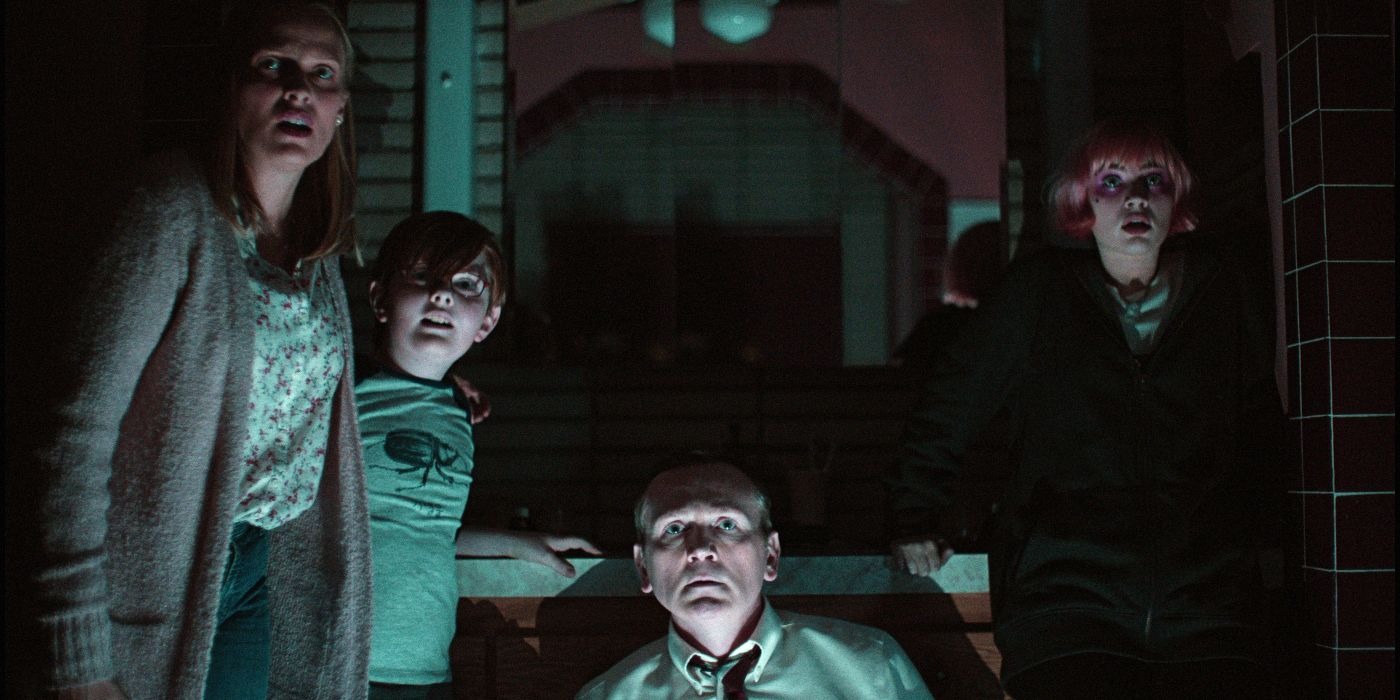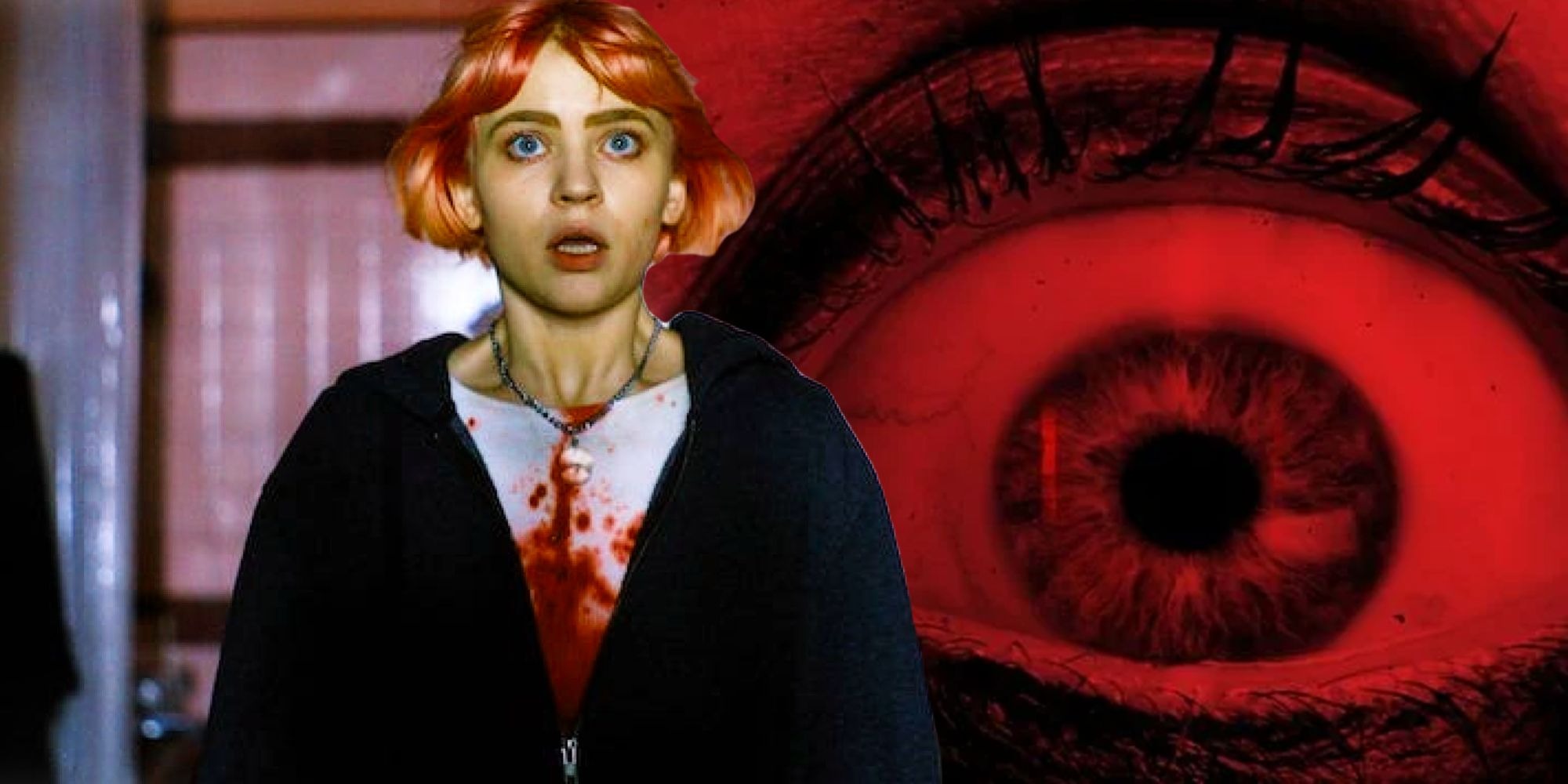A chilling sense of doom builds up in We Need To Do Something, reaching its peak in the final moments when the last two remaining characters suffer a gruesome fate offscreen, their deaths inflicted by an unknown entity. The unsettling end mirrors Max Booth III’s novella of the same name, focusing on the terror of being trapped.
A family of four finds themselves locked inside a bathroom, hoping to ride out a heavy storm. However, instead of safety, the confined space becomes a pressure cooker of unresolved conflicts and an escalating threat from the unknown outside.

Before the disturbing final scenes, the film presents its central character, Melissa. Played by Sierra McCormick, Melissa embodies the classic traits of a rebellious teenager—detached from her family, struggling with self-identity, and expressing herself through a gothic fashion sense, including dark clothing and striking pink eyeshadow.
From the very beginning, her desperation is apparent as she frantically tries to contact her classmate Amy (portrayed by Lisette Alexis) through multiple text messages, all of which remain unanswered.
Meanwhile, her younger brother Bobby (John James Cronin) clings to their mother, Diane (Vinessa Shaw), while their father, Robert (Pat Healy), changes unpredictably between aggression and cold detachment.
A mix of surrealism and disturbing horror defines the ending of We Need To Do Something, featuring grotesque elements such as a severed tongue writhing on its own before being consumed by the starving family.
Trapped without a way out, tensions boil over as they are forced to confront fear in its purest form. Throughout the film, director Sean King O’Grady relies heavily on suggestion, allowing much to remain unseen and left to the imagination.
However, by the final act, this approach is pushed to its breaking point, delivering an ending that offers little relief or clarity.
Understanding the Meaning Behind We Need To Do Something’s Ending
The shocking impact of the film’s ending plays a central role in its execution, as O’Grady crafts a conclusion that is abrupt and deeply unsettling. Diane and Melissa, the last two survivors, are left screaming in terror as an unseen force starts tearing through the bathroom door.
Just before this, Diane had removed a brick from the wall, creating a small opening to look outside. What she sees leaves her frozen in horror—she stumbles back into the room covered in blood, unable to describe what she witnessed.
As they barely have time to process the situation, panic takes over once more as an unknown force violently breaks in, filling the screen with an ominous red glow. Their survival is cut short, but the exact cause of their deaths remains ambiguous.
One of the biggest mysteries left unanswered is whether the monstrous presence outside is real or a reflection of Melissa’s overwhelming guilt. Diane is already consumed by grief after Bobby dies from a venomous rattlesnake bite.
At the same time, Robert spirals into uncontrollable rage when Melissa reveals that she and Amy performed a hex, possibly setting off the terrifying events. His sudden blindness adds to the turmoil, causing him to lash out violently at Diane.
In a desperate bid to protect her mother, Melissa takes a weapon and bludgeons her father to death. These disturbing developments are intentionally left open-ended. Were supernatural forces truly at play, or was the family doomed from the start due to their deeply fractured relationships?
Were Melissa’s visions a glimpse of impending disaster, or were they just hallucinations brought on by stress and fear? Instead of answering these questions, the film leans into uncertainty, ensuring that viewers are left questioning what is real and what is imagined.
The Mystery of the Creature in We Need To Do Something
Despite the overwhelming fear it instills, the monstrous presence responsible for the chaos is never fully revealed. The audience is only given hints—its demonic voice, its ability to rip through barriers, and its brutal nature.
By keeping the creature unseen, the film deepens its atmosphere of dread, leaving viewers to imagine something far worse than anything shown on screen. One of the most disturbing moments in the film occurs when Melissa, in desperation, rips out the still-moving tongue of a demonic dog and urges her family to eat it for sustenance.
With no access to food, their options are grim, forcing them into a horrifying decision. The film builds its horror around their entrapment—the bathroom door is completely blocked by a fallen tree, making escape impossible.
The setting intensifies the terror even further. The bathroom, lined with large glass panels and seemingly indestructible tiles, becomes an eerie prison. At one point, an exasperated Melissa mutters, “We need to do something,” a phrase that captures the growing sense of panic.
Robert, however, dismisses any attempt at escaping, insisting that their fate is in the hands of forces beyond their control. Throughout the film, eerie growls and distant sounds from outside remind them that something unearthly lurks just beyond the walls, waiting.
The Reason Behind Amy and Melissa’s Hex
A haunting flashback sheds light on the event that may have set everything in motion. Melissa and Amy had a classmate named Joe, whose disturbing and intrusive behavior included secretly recording the two girls in an intimate moment.
In response, Amy cast a hex on Joe, using the severed tongue of a dead dog as part of the ritual. Things quickly spiral into chaos when Joe unexpectedly dies.
Amy, who suffers from Cotard’s Delusion—a rare condition where an individual believes they are already dead—confesses that she performed the ritual as a way to feel something real. She insists that the spell awakened an ancient force within her, something powerful enough to unleash destruction upon the world.
Though the film does not confirm it outright, there are strong suggestions that the ritual tore open a rift between realities. The unnatural occurrences that follow seem to hint that the supernatural has taken hold of Melissa as well, even if only briefly, before setting off the catastrophic storm that plunges them into horror.
Differences Between the Book and Film Versions of We Need To Do Something
While the movie remains largely faithful to the book, there are a few variations in how the events are presented. The most important difference lies in how the ending is framed. The film leans heavily into supernatural horror, while the book keeps the truth more ambiguous.
In Booth’s novella, the storm that traps the family is not merely a random disaster—it is suggested that Melissa and Amy’s actions may have caused something far worse, possibly the collapse of the world as they knew it.
The film, on the other hand, focuses more on the immediate horrors within the confined space rather than the larger implications of their ritual. Additionally, the book places greater emphasis on the devastation caused by the girls’ hex, making their involvement in the catastrophe even more pronounced.
While both versions maintain the core plot—Diane and Melissa being the final survivors and Melissa being attacked by Amy—the book offers a more in-depth depiction of Melissa’s psychological torment. Rather than ending with the creature’s attack, the novel paints a harrowing picture of her experiencing terrifying visions of reality breaking apart.
The Effectiveness of We Need To Do Something as a Horror Film
One of the strongest aspects of the film is its unpredictability. Stories centered on characters being confined to a single location are not new to horror, with films like Fermat’s Room and Cube adopting similar approaches.

However, We Need To Do Something introduces unusual elements that create a sense of unease, blending surreal horror with psychological tension. The deep-seated fear of isolation plays a major role throughout the movie, a theme that feels even more relevant in a world still recovering from lockdowns and widespread uncertainty.
The idea of being cut off from the outside world, trapped in a space where danger is both near and unknown, enhances the psychological horror. From the start, Melissa’s frustration is evident—being stuck with her family while losing all communication with Amy fuels her desperation.
Her yearning to escape is not just about physical confinement but also about reconnecting with the one person she truly felt drawn to before everything fell apart. Beyond the supernatural elements, the film also highlights Robert’s abusive behavior, which makes an already unbearable situation worse.
Instead of providing a sense of security, his volatile nature adds another layer of fear. His interactions with Diane are filled with hostility, and his dismissive attitude only fuels the tension. For both Bobby and Melissa, the unpredictability of their father’s aggression is just as terrifying as the unseen forces lurking outside.
The film does not shy away from crossing boundaries that many horror movies avoid, including the brutal fate of a child early on. Bobby’s tragic death serves as a stark reminder that no one is safe, and his decaying body remains a disturbing presence in the room.
As paranoia and guilt take hold, the family begins turning on each other, further amplifying the horror. With its blend of surreal imagery and psychological dread, the film continuously defies expectations, making it a uniquely disturbing entry into horror cinema.



